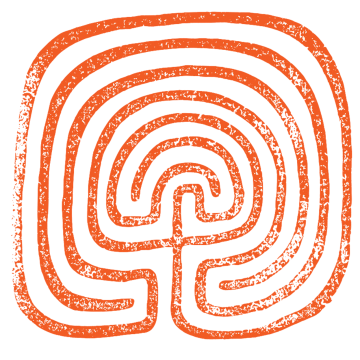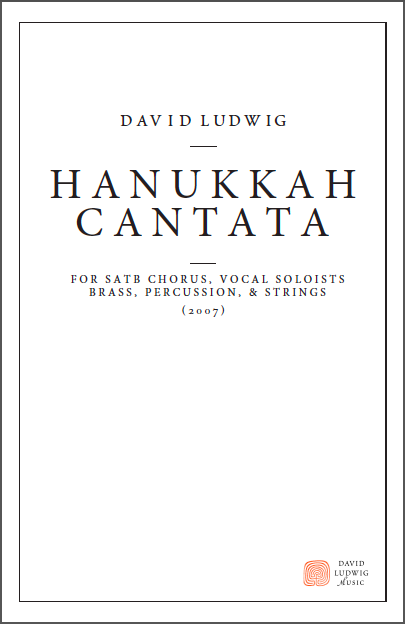Hanukkah Cantata
Hanukkah Cantata (2007) - 24' (Trad. Hebrew and English)
-SATB Choir + soloists, 0000 0130 percussion, organ, strings
-Commissioned by Choral Arts Philadelphia
-Premiered 2007 at Rodeph Shalom, Philadelphia
Rental information
Program Listing
Hanukkah Cantata (2007)
I. "Mi Y'maleil" Chorus
II. Recitative (Tenor) "A sinful root"
III. Aria-Recitative (Bass/Tenor) Matthias: "Why was I born to see this?"
IV. Al Hanisim (Chorus)
V. Recitative (Tenor/Chorus) "Thus Israel had a great deliverance"
VI. Candle Blessings (SA Chorus)
VII. Dredyl Dance (with narration)
VIII. Maoz Tzur (Chorus)
Program Notes
The Hanukkah Cantata was written for Choral Arts Philadelphia and was funded by the Philadelphia Music Project. I wrote the cantata with a lot of help from some good friends and fabulous musicians, but my first word of thanks has to go to Cantor Dan Sklar who not only assembled and translated the texts for me, but also sang the wonderful Hannukah songs for me to hear. I remembered Dan’s voice all the while I arranged these songs.
When Choral Arts director Matt Glandorf asked me to write a piece for the holiday, I immediately saw the challenge of writing a new work to commemorate an ancient tradition. It would need to be accessible to an audience whether or not they are familiar with the story of the holiday. I decided to integrate Hanukkah songs in their original Hebrew with the narrative taken from Scripture as translated into English. It was important for me that the piece be set in the “vernacular,” so to speak, but to also preserve what is to me beautiful folk music. To that end I kept the music within the boundaries of functional sacred music, rather than attach it to a more abstract musical language or idiom.
I also knew the piece would have to be in eight movements. I wanted to style it after the customary practice of including soloists in recitative and arias who would convey the thread of the story poetically. This made the arc of the piece clear to put together. The opening comes with a question from the traditional song “Mi Y’maleil”: “who can recount the feats of the holy land?” The next two movements tell of the oppression of the Jews through the eyes of their ruler Mattathias, as well as the rise of his son Judas Maccabeus. After Judas is pronounced “blessed,” in the fourth movement, the women of the chorus sing the traditional candle blessings sung while lighting the Menorah.
The fifth movement opens the second half of the piece, and details the triumph of the Jews over their oppressors. Here, they find their most holy temple desecrated; and this is where the real heroism takes place. Rather than give up or give in, they decide to completely rebuild and rededicate the temple, replacing every defiled stone anew—even constructing a new altar like the previous one. The music turns to the triumphant “Al Hanisim” to commemorate the occasion.
The seventh movement is instrumental dance music; a “dreydl dance” with a narration that is meant to capture both traditional sonorities of Jewish music and incorporate the importance of dance into the cantata. The narrator’s part is to tell the how the story happened when the Jews decided to reconstruct the temple and the miracle that occurred when they found only enough oil to light their lamp for one day. They needed enough oil to last for eight days, or enough time to consecrate the next batch of fuel. As it so did, miraculously confirming the merit and holiness of their efforts.
The final movement is another arrangement of the song “Maoz Tzur,” which is a song that will be familiar to many. The medieval nature of the words conveys the unfortunate glorification of war (a matter I tried to avoid in arranging the text, given the state of our world. I see no reason to exalt the killing of anyone, including the “enemy,” “foe,” or “heathen.”) But the story of the last song, and indeed the story of Hannukah is about oppression, loss, and overcoming that loss to move on with strength and love. The Jews defeat their oppressors and then grieve for their losses. The heroism of the story is in the rebuilding after that loss, and the power of the community unified to help the individuals of that community continue on. They construct a new altar after losing the old one, yet, significantly, it is not a “new” altar insofar as it acknowledges and never forgets the loss.
My nephew, Michael Henry Ludwig, who would have celebrated his tenth Hannukah this year passed away suddenly and unexpectedly just four days before writing this program note. He was a magnificent kid, always enthusiastic, beaming and smiling when I would bring him close and rub my knuckles on his head. Choral Arts Philadelphia graciously agreed to dedicate the first performance to Michael—the premiere of this work was in the temple of his great grandparents. Every day I didn’t spend with him feels like time lost. I am honored to be able to remember him with this music.
Press
"The fourth and fifth numbers began the Hanukkah Cantata by David Ludwig, a trio of beautiful songs sung in both Hebrew and English" – Palisades News

